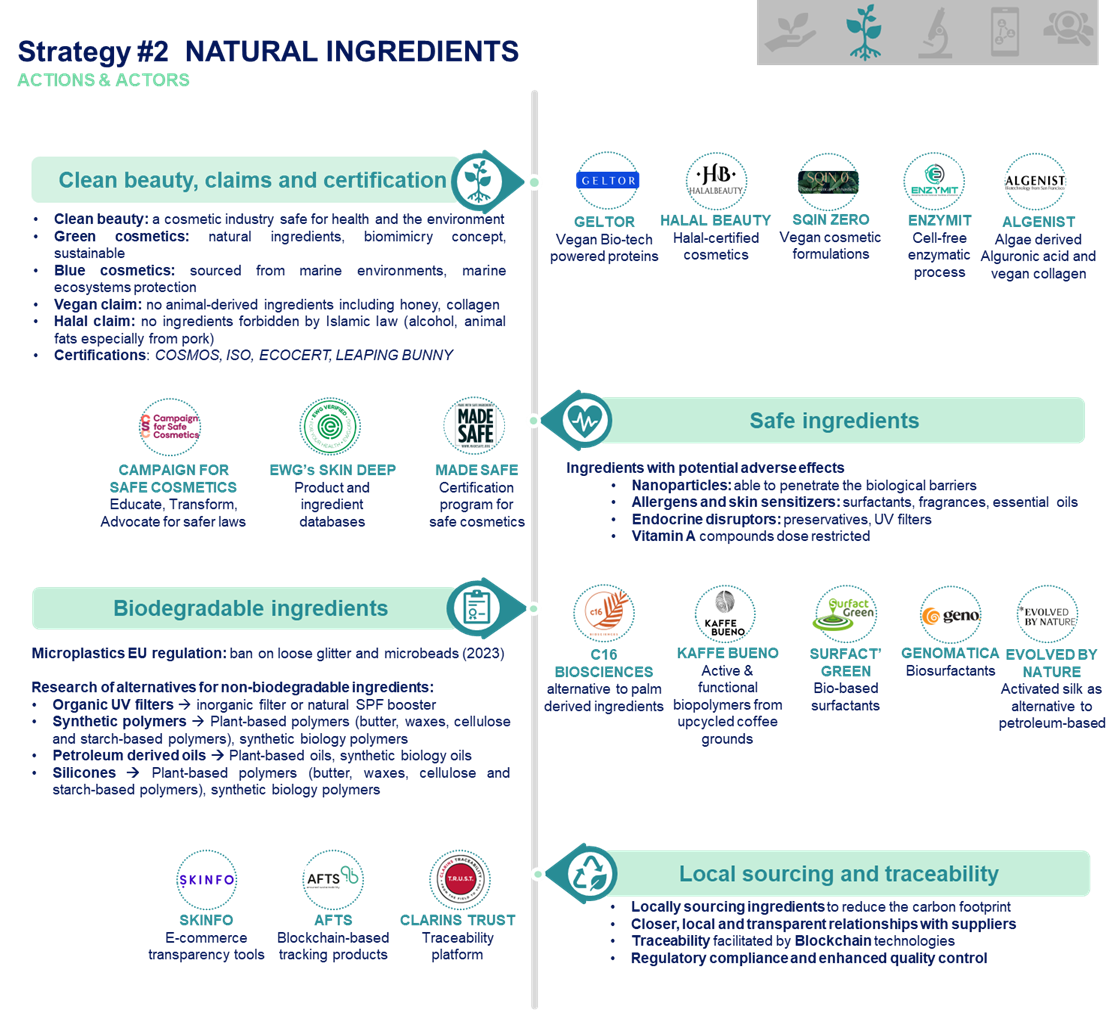STRATEGY #2: NATURAL INGREDIENTS
The market is increasingly leaning towards products featuring natural and organic components, steering clear of ingredients that are contentious or could pose health risks. Simultaneously, there’s an escalating movement towards “clean beauty,” spotlighting ingredients that are non-toxic and safe. Despite the burgeoning interest in clean beauty products, the industry confronts significant hurdles, such as the lack of a unified regulatory authority or standardized norms across the industry, and the risks posed by imitation beauty products. Often perceived as both safer for consumers and more eco-friendly compared to synthetic alternatives, these ingredients might also be more effective at addressing specific skin concerns.
Here are actions set up in order to move towards a cleaner beauty:
- The promotion of claims & certifications
- The promotion of safe ingredients
- The promotion of biodegradable ingredients
- Guaranteeing a local sourcing and traceability
-
Clean beauty, claims & certification
Clean beauty refers to a movement within the cosmetics industry that emphasizes the use of products made with ingredients that are considered safe for health and the environment. In addition, it is also about a commitment to transparency, ethical sourcing, and environmental responsibility.
The term Green cosmetics refers to the use of natural ingredients, which are derived directly from nature, ensuring minimal processing to retain their purity and effectiveness. The allure of natural ingredients lies in their perceived safety and compatibility with the skin, appealing to consumers who are cautious about synthetic chemicals. Furthermore, the concept of biomimicry plays a pivotal role in this sector. Biomimicry involves creating products that emulate natural biological processes or structures. For instance, skincare products might mimic the hydrating properties of certain plants or the regenerative abilities of specific natural enzymes. The interest in green cosmetics, natural ingredients, and biomimetics reflects a broader industry shift towards environmental responsibility, consumer health consciousness, and a fascination with the ingenious ways in which nature solves complex problems. This shift is not just a marketing trend but a fundamental change in how products are formulated, positioning the cosmetic industry at the forefront of sustainable innovation.
The term Blue Cosmetics refers to beauty products that are formulated with ingredients sourced from marine environments, such as seaweed, algae, marine collagen, and fish oils. These products are valued for their rich mineral content and unique properties like hydration, anti-aging, and skin-repairing benefits. However, the term also encompasses a broader commitment to the conservation of marine ecosystems. Blue cosmetics brands typically engage in sustainable sourcing practices to ensure minimal impact on oceanic environments and may be involved in initiatives aimed at preserving marine biodiversity.
A “vegan” claim on cosmetic products indicates that the product does not contain any animal-derived ingredients or by-products. This includes common ingredients like honey, beeswax, lanolin, collagen, albumen, carmine, cholesterol, and gelatin. Vegan cosmetics are different from “cruelty-free” products, which specifically refer to products not tested on animals. Consumers choose vegan cosmetics for various reasons, including ethical concerns about animal rights, environmental reasons, and personal health preferences.
Halal cosmetics must not include ingredients that are forbidden by Islamic law, such as alcohol and certain types of animal fats, especially those derived from pigs. This often includes a refusal of animal testing. Products should be manufactured, packaged, and stored in a way that maintains their purity. Many halal cosmetic products also emphasize the use of natural ingredients and environmentally friendly manufacturing practices.
Regarding certifications, COSMOS certification, with its stringent guidelines for organic and natural cosmetics, ensures products meet high environmental and health standards. Similarly, ISO approval, a globally recognized mark, assures product quality and safety. ECOCERT certification goes further, emphasizing environmentally friendly and socially conscious production practices. Leaping Bunny certification indicates that a product is cruelty-free and has not been tested on animals at any stage of product development Linking these certifications is the growing importance of local sourcing and traceability.
Actors
- Halal Beauty, an American start-up producing cosmetics made with natural, cruelty-free and halal-certified ingredients.
- SQIN ZERO, a Swiss start-up producing sustainable and vegan cosmetic formulations.
- Enzymit, a startup based in Ness Zina in Israel, developed a cell-free enzymatic manufacturing technology, synthetically producing hyaluronic acid (HA) for use in a range of cosmetic, aesthetic, and therapeutic applications.
- Algenist, a Californian company that has patented alguronic acid ingredients which is described as “more effective than hyaluronic acid, vitamin C, retinol, vitamin E, and other anti-aging ingredients in triggering collagen production, elastin synthesis and cell regeneration”. The company also supplies vegan collagen.
- GREENTECH, a French company that develops and produces high-tech active ingredients from natural sources from the plant, marine and microbial worlds thanks to its different dedicated companies: GREENTECH, GREENSEA and GREENCELL.
- CODIF TECHNOLOGY NATURELLE, based in Brittany, France, is a key player in glyco-chemistry derived from blue biotechnology.
- ABYSS INGREDIENTS, a biotech company based in Brittany, France, which is proposing innovative and objective marine health active ingredients.
- ALGANELLE, a French innovative biotechnology company specializing in the development and production of high-value natural molecules from microalgae, used as photosynthetic cellular factories.
- AGRIMER, localized in Brittany, France, is a specialist in marine cosmetics and has always sought to enhance marine resources (seawater, algae, halophyte plants) for their beauty and wellness properties.
-
Safe ingredients
The cosmetic industry is increasingly scrutinizing its use of certain ingredients due to their potential adverse effects on health.
Nanoparticles are ultrafine particles with dimensions measured in nanometers. They are used in cosmetics for various purposes, such as providing UV protection in sunscreens or enhancing the penetration of active ingredients. However, their small size raises concerns about potential toxicity and the ability to penetrate the skin or enter the body through inhalation. Research is ongoing to fully understand the implications of nanoparticle use, but as a precaution, regulatory bodies in many regions have implemented strict guidelines. These guidelines often require rigorous safety testing and labelling to inform consumers about the presence of nanoparticles in products.
Allergens and skin sensitizers are a large group of compounds drawing attention of toxicologists. Some of the common allergens in cosmetics include certain fragrances, preservatives, and natural ingredients like essential oils and plant extracts. Even ingredients generally considered safe can cause allergic reactions in sensitive individuals. Some surfactants, particularly sulfates like sodium lauryl sulfate (SLS) and sodium laureth sulfate (SLES), are known to be harsh on the skin. They can strip away natural oils, leading to dryness, irritation, or allergic reactions, especially in sensitive individuals. Moreover, Kojic acid, once a popular ingredient, is now restricted owing to its potential as a skin irritant. In addition, alpha-arbutin is now dose restricted.
As
Endocrine disruptors are another significant area of concern. Preservatives like parabens are increasingly scrutinized for their endocrine-disrupting effects. Compounds such as Genistein and Daidzein, known as phytoestrogens, are restricted in formulations due to their estrogenic activity that may disrupt endocrine function. Triclocarban is also now dose-limited in product formulations. While essential for preventing skin damage, certain UV filters have come under scrutiny for potential health risks. For example, chemical filters like oxybenzone and octinoxate have been questioned for their potential endocrine-disrupting effects. Recently, 4-methylbenzylidene camphor, was banned from cosmetics because of its potential health risks.
This growing awareness and regulatory action highlight the industry’s shift towards safer, more skin-friendly formulations.
Actors
- BCPP’s Campaign for Safe Cosmetics (CSC) a Californian program that protects people and the planet from toxic beauty in three ways: educating the public; transforming the outdated cosmetics industry; and advocating for safer laws.
- EWG’s Skin Deep, a US environmental working group developing Skin Deep® product and ingredient databases compares the ingredients on personal care product labels and websites to the information in nearly 60 toxicity and regulatory databases. When a product is EWG VERIFIED®, it means it meets EWG’s strict, scientific standards for transparency and health. Their team of toxicologists, chemists and epidemiologists scrutinizes every product, empowering the customer to purchase safer products.
- Made Safe® logo is, first and foremost, a non-toxic certification indicating a product is free of any toxic ingredients known or suspected to harm human health, animals, or ecosystems. They are currently “the only human health and ecosystem-focused product certification program”.
-
Biodegradable ingredients
Non-biodegradable cosmetic ingredients are those that do not break down easily in the environment and can persist for a long time, potentially causing ecological harm. Here are some common non-biodegradable ingredients found in cosmetics: microplastics (less than 5mm in size), silicones (dimethicone and cyclomethicone), petroleum derived oils, synthetic polymers (PE, PP, PMMA and nylon), certain UV filters (oxybenzone, octinoxate, Benzophenone-3, Octocrylene). Many cosmetic companies are now reformulating products to exclude these ingredients or to find environmentally friendly alternatives with similar functional properties.
Microplastics do not biodegrade, but accumulate in animals, including fish and shellfish, and are consequently also consumed as food by humans. The European Commission adopted the restriction on 25 September 2023 with the first measures being the ban on loose glitter and microbeads.
Organic UV filters include aminobenzoic acid, avobenzone, cinoxate, dioxybenzone, ecamsule, ensulizole, homosalate, meradimate, octinoxate, octisalate, octocrylene, oxybenzone, Padimate O, sulisobenzone, and trolamine salicylate; inorganic UV filters include titanium dioxide (TiO2) and zinc oxide (ZnO). The main challenges are understanding and measuring the environmental effects of UV filters to characterize real-world exposures. Alternatives to non-biodegradable UV filters in sunscreens include inorganic filters Zinc oxide and titanium dioxide which are natural minerals that provide broad-spectrum UV protection. These are often used in “physical” or “mineral” sunscreens. However, sensitive habitats with slow currents, such as coral reefs, may accumulate these nanomaterials. Some newer organic compounds are designed to be more environmentally friendly and biodegradable, reducing the impact on marine ecosystems. Bio-based UV Filters are derived from natural sources such as plants, and are developed to be both effective in sun protection and biodegradable. Certain plant extracts and oils have natural UV absorbing properties. These include ingredients like red raspberry seed oil and carrot seed oil. Research is also ongoing to modify existing chemical UV filters to make them more biodegradable while maintaining their effectiveness, for instance removing PEGs and other unwanted materials.
Petroleum-based cosmetic ingredients derived from crude oil such as mineral oil, petrolatum, and paraffin, are subject to various concerns related to health, environmental impact, and ethical considerations. Existing alternatives include plant-based oils and butters, natural waxes, cellulose and starch-based polymers, sugarcane-derived ingredients or synthetic biology ingredients.
Regarding silicones, scientific advances have enabled the development of silicone-like, natural ingredients that mimic the properties of silicones without harmful environmental or health effects. They are often derived from plant sources and completely biodegradable.
Finally, third-generation feedstocks, such as algae, microorganisms, and certain kinds of biomass, are often more sustainable than traditional sources. They can be cultivated with minimal impact on food supply and often require less land and water. This aligns with the growing demand for sustainable and eco-friendly products in the cosmetics industry.
Actors
- Lubrizol Life Science , a US company, commercializes SilSense™ Bio 5 Emollient is a long-lasting silicone alternative to D5 Cyclopentasiloxane that provides the same performance and sensoriality in leave-on applications, particularly for skin care, hair care, body care sunscreen and makeup formulations.
- Lubrizol Life Science develops Sunhancer™ eco SPF booster which is composed of micronized particles made from a blend of naturally derived and sustainably sourced waxes. It is biodegradable and non-persistent in the environment.
- Kaffe Bueno, a Danish Bioscience company using upcycled spent coffee grounds to generate active and functional ingredients, serving as replacements for unsustainable natural ingredients like argan oil or palm oil derivatives, petrochemicals and synthetics. One of the ingredient, KAFFAGE™ is an upcycled amphiphilic biopolymer with high antioxidative and anti-glycation activity, which can act as a natural SPF booster.
- BASF Personal Care, a German company that has worked on silicone alternative cosmetic ingredients such as fast-spreading oils Cetiol® C5, Cetiol® Ultimate and Cetiol® OE.
- SOPHIM, a French manufacturer of natural emollients, offers a natural alternative to silicone, Biophytosebum, of olive plant origin, which is a particularly suitable substitute for volatile silicone in your face-, body- and hair-care applications.
- Evonik, based in Germany, produces glycolipids biosurfactants which are excreted by an organism during biological synthesis. “This makes them one hundred percent natural surfactants. Among all biosurfactants used in the cosmetic and personal care industry, glycolipids are the most widely studied and commercialized due to their multifunctional profile, biocompatibility and eco-friendliness, especially based on their physiochemical properties and biological activities.”
- SURFACT’GREEN, a Breton chemical startup from Rennes, developing 100% green bio-based surfactants for the personal care industry.
- Genomatica, based in California, deploys its proven biotechnology platform, using patented microorganisms to ferment plant sugars that produce ingredients to make sustainable surfactants. These new ingredients will be used in a range of L’Oréal, Unilever and Kao Corporation products and are seen as alternatives to unsustainable ingredients like palm oil and fossil fuels.
- Evolved by Nature, a US biotech company providing a film forming ingredient based on activated silk or silk fibroin (Activated silk™ 33B-α) a sustainable way to replace petroleum-based ingredients like ceramides, dimethicone, and liquid plastic acrylates. Activated silk is valued for its natural protein structure, which is compatible with human skin. It is used for its moisturizing properties, ability to form breathable films on the skin, and potential to deliver other active ingredients effectively.
- Symrise’ German company portfolio includes Hydrolite® 5 green made by a patented process from bagasse, a by-product derived from sugar cane which is ethically and responsibly sourced.
- C16 Biosciences, a US biotech startup using a fermentation process to produce a sustainable alternative for palm oil and palm derived ingredients.
- Biossance is a Californian vegan skincare brand creating its own eco-friendly squalene, an ingredient typically taken from shark livers.
-
Local sourcing and traceability
Local sourcing and traceability represent key innovation strategies in the cosmetic industry, driven by evolving consumer expectations and a growing emphasis on sustainability. By locally sourcing ingredients, cosmetic companies can significantly reduce their carbon footprint, a critical factor in an increasingly eco-conscious market. This approach also supports local economies and enables companies to establish closer, more transparent relationships with suppliers, ensuring higher quality and fresher ingredients. Traceability, often facilitated by advanced technologies such as blockchain, plays a vital role in this strategy. It allows companies to track the journey of each ingredient from source to shelf, providing a clear, verifiable narrative of their products’ origins and manufacturing processes. This transparency fosters greater consumer trust and loyalty, as customers increasingly seek assurances regarding the ethical and environmental implications of their purchases. Moreover, traceability aids in regulatory compliance and enhances quality control, further positioning companies as responsible and forward-thinking market leaders.
Actors
- Skinfo, a company from Sweden, provides consumers with the power to make informed choices by offering transparency tools for beauty product ingredients on e-commerce websites. The widget details each ingredient’s function, effects on the skin, allergen information, vitamin content, botanical terminology, and their origins.
- AFTS, a German startup, is pioneering a blockchain-based solution for tracking cosmetic products, focusing on assessing the sustainability of their production. This initiative aims to enhance transparency and traceability in the cosmetic industry’s supply chain, thereby building greater consumer confidence.
- Clarins Trust from French company Clarins, introduces a traceability platform utilizing Neurochain blockchain technology. This platform, named Clarins TRUST (an acronym for Traceability, Responsibility, Uniqueness, Security, Transparency), focuses on tracing the supply of raw materials and calculating carbon impact. Accessible via the Clarins website, consumers can simply enter their Clarins product’s batch number to trace its complete journey.
Sources:
Websites articles:
- Innovation and Future Trends in the Cosmetic industry. Cosmetics Europe website. https://cosmeticseurope.eu/cosmetics-industry/innovation-and-future-trends-cosmetics-industry/
- Roberts, R. (2022, June 22nd). 2022 Beauty Industry Trends & Cosmetics Marketing: Statistics and Strategies for Your Ecommerce Growth. Common Thread collective website. https://commonthreadco.com/blogs/coachs-corner/beauty-industry-cosmetics-marketing-ecommerce
- Berg, A; Hudson, S; Klitsch Weaver, K; Lesko Pacchia, M and Amed, I. (2023, May 22nd). The beauty market in 2023: A special State of Fashion report. Mckinsey website. https://www.mckinsey.com/industries/retail/our-insights/the-beauty-market-in-2023-a-special-state-of-fashion-report
- Vogl, M. (2023, October 2nd). 6 Beauty Industry Consumer Trends Marketers Should Be Watching. Website of Brandwatch. https://www.brandwatch.com/blog/beauty-industry-consumer-trends/
- MCKINSEY & COMPANY. (2023, June 13th). How to Decode Gen-Z’s Evolving Relationship With Beauty. Website of business of fashion. https://www.businessoffashion.com/articles/beauty/the-state-of-fashion-beauty-report-gen-z-diversity-consumer-behaviour-trends/
- Schmidt, S. (2023, February 17th). 5 Top Cosmetics Industry Trends to Watch in 2023 and Beyond. Website of Market research. https://blog.marketresearch.com/5-top-cosmetics-industry-trends-to-watch
- Interesse, G, China Briefing. (2023, July 20th). China’s Cosmetics and Personal Care Market: Key Trends and Business Outlook. Website of Chine Briefing. https://www.china-briefing.com/news/chinas-cosmetics-and-personal-care-market-key-trends-and-business-outlook/
- (2021, May 25th). 14 Trends Changing The Face Of The Beauty Industry In 2021. Website of CB INSIGTHS. https://www.cbinsights.com/research/report/beauty-trends-2021/
- Trends in the Cosmetics Industry US and Europe. Website of Snipp. https://www.snipp.com/cosmetics-industry-trends
- Doolan, K. (2023, Dec 22nd). Cosmetic regulations round-up: 2023. Website of Cosmetics Design Europe. https://www.cosmeticsdesign-europe.com/Article/2023/12/22/Cosmetic-regulations-updates-for-Europe
- (2023, Sep 25th) Protecting environment and health: Commission adopts measures to restrict intentionally added microplastics. European Commission Website. https://ec.europa.eu/commission/presscorner/detail/en/ip_23_4581
Review articles:
- Ustymenko, R. (2023). TRENDS AND INNOVATIONS IN COSMETIC MARKETING. Economics & Education, 8(3), 12-17. https://doi.org/10.30525/2500-946X/2023-3-2
- J. Pharm. Sci. Rev. Res., 68(1), May – June 2021; Article No. 30, Pages: 190-197. http://dx.doi.org/10.47583/ijpsrr.2021.v68i01.030
- Pawlowski et al. International Journal of Cosmetic Science. 2023;45(Suppl. 1):52–66. https://onlinelibrary.wiley.com/doi/10.1111/ics.12898









